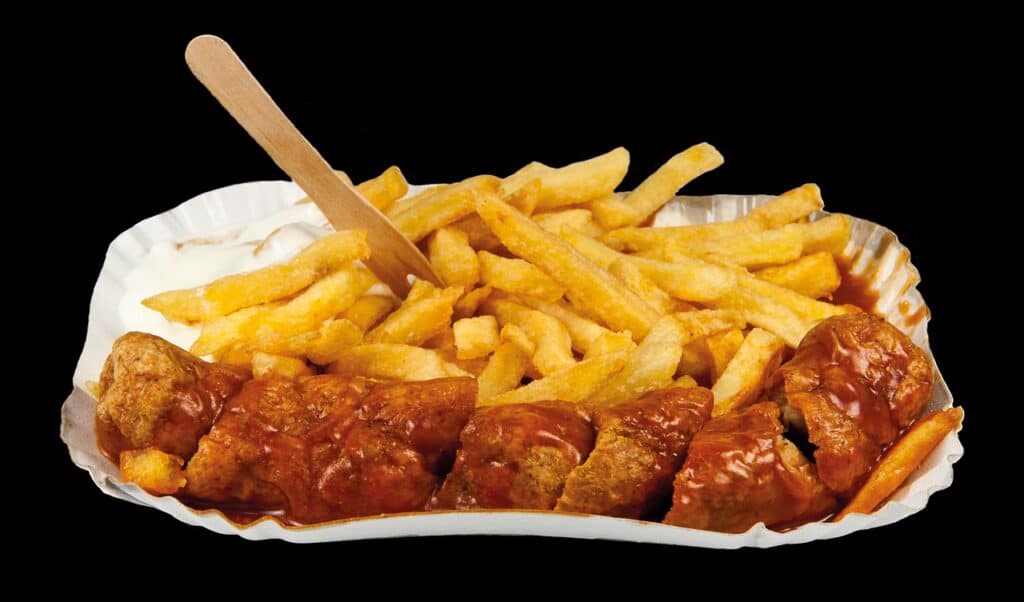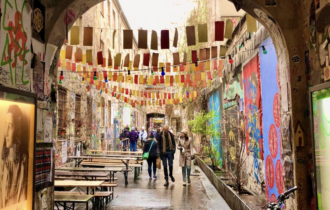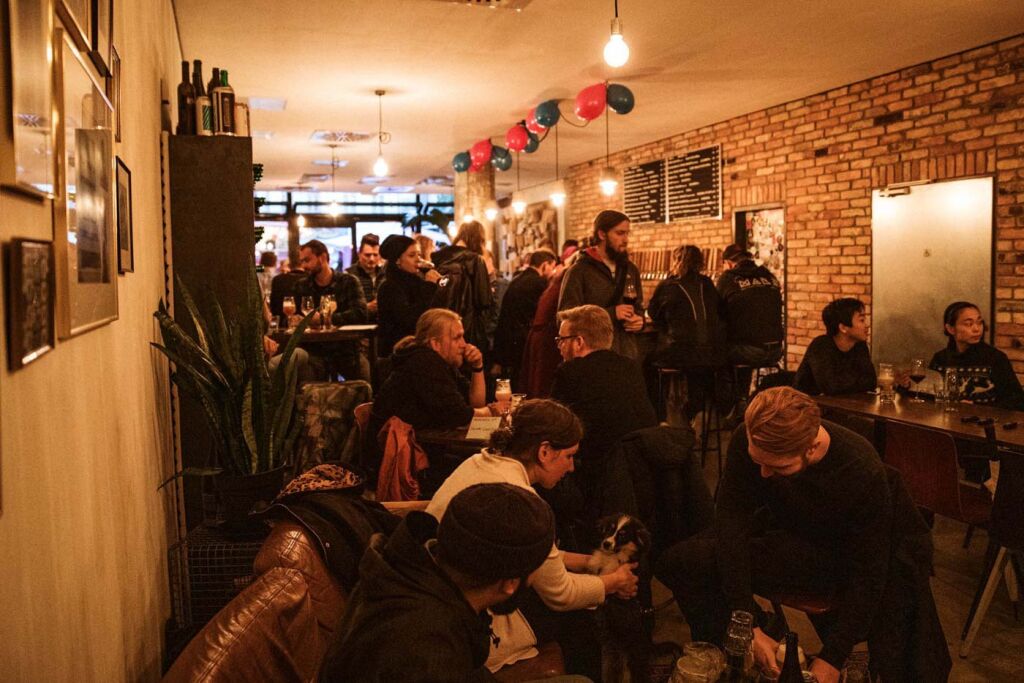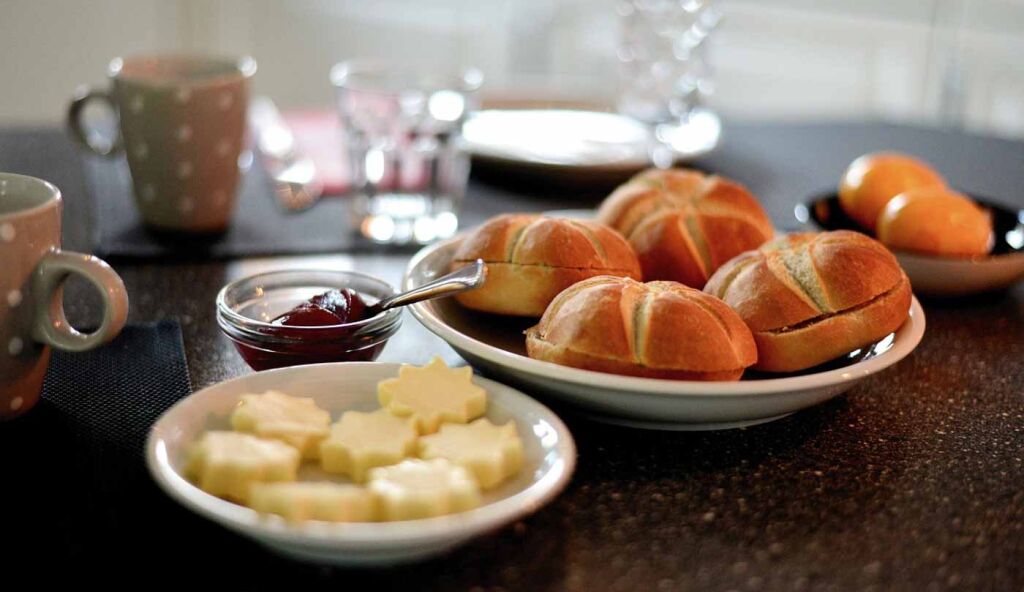Berlin is one of Europe’s most diverse cities. A mix of different nationalities and German people residing here shapes the city’s street food scene. Traditional currywurst, deep-fried pfannkuchen, and döner kebab are all sold on almost every corner.
I’ve spent a lot of time here developing my Berlin food tours and have really dived into the street food culture to see what it has to offer my customers.
From exciting food events serving fresh falafel to food trucks with queues leading down the street, I was amazed as an American at how diverse the street-side dining scene is here.
So, come on, join me as I present to you a lineup of the best street foods in Berlin.
Currywurst
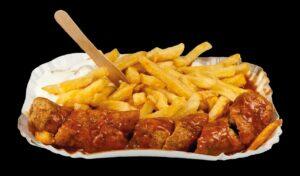
Often hailed as the holy grail of German street food stalls, currywurst is made up of steamed and fried sausage chopped into pieces, french fries, and covered in a mix of curry powder and tomato ketchup.
Currywurst originated from a German housewife who traded spirits with British soldiers in 1949. She received ketchup in return and added it to her chopped sausage, and Berliners received currywurst as a result.
The recipe then became hugely popular among low-paid construction workers and grew from there.
Where To Eat It?
If you can bear the infamous long queues of Curry 36, you’ll be treated to an extremely delicious version of the dish.
Located in Mehringdamm 36 on the U6 line, I accidentally stumbled across this place when I jumped off the U-Bahn one day and only found out how famous it was afterward.
When I eventually tackled my way to the top of the line and snagged my order, the currywurst came on a white plate; the sausage was chopped into lots of mini pieces with a fork stuck in the center.
When I first tasted the sauce, I was unsure what to think of its spicy, smoky, and tomatoey flavors; it was a weird combination to adapt to. But after a couple of more mouthfuls, I grew to enjoy it, especially the savory notes from the sausage and the crispiness from the French fries.
Curry 36 (€) – Mehringdamm 36, 10961 Berlin, Germany – Every day, 9:00 am to 5:00 am
Pfannkuchen

Pfannkuchen are circle-shaped pastries sold in stores and Berlin street food markets across city. They’re a deep-fried snack and have a filling inside, usually jam; one for me is never enough.
They look exactly like donuts and are glazed on the outside, but the Germans, being Germans, have to put their own stamp on things. The recipe dates back to the Middle Ages, but it’s funny because the word pfannkuchen literally translates to pancakes.
Pfannkuchen is made by frying the dough in a pan; the chef usually waits until it turns golden brown in color, then removes it and glazes it before serving.
Where To Eat It?
There’s this one place on the east side of the city that specializes specifically in pfannkuchen called Sugarclan – Original Berliner Pfannkuchen. It lies beside the peaceful Boxhagener Platz and is a little factory offering takeaway versions of the specialty.
I love the smell of the dough that takes over your senses when you get up to the front counter. Amazingly, you can see the chefs working their magic in the back and the hard work that goes into perfecting each of these little sweet treats.
They offer lots of variations of pfannkuchen. I was quite overwhelmed when it came to choosing one, but the dulce de leche bomb won it for me.
Words can’t describe the rich and creamy soft caramelized mix of sauce that leaked into my mouth as I dug my teeth into the fluffy, eggy dough and the vanilla notes from the glaze on the exterior.
Sugarclan – Original Berliner Pfannkuchen (€) – Grünberger Str. 85, 10245 Berlin, Germany – Closed Monday and Tuesday, Wednesday to Friday, 11:00 am to 7:00 pm, and Saturday and Sunday, 10:00 am to 6:00 pm
Döner Kebab
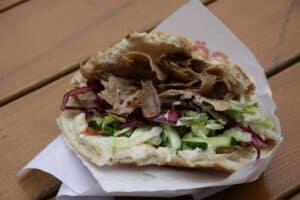
Brought to West Berlin in 1972 by the great Turkish restaurant Kadir Nurman, the döner kebab can be found in all corners of the city, whether you’re on a walk around the Mauerpark or the Arminiusmarkthalle Food Market Hall.
The döner kebab recipe is a Turkish fusion of ingredients, including seasoned beef or lamb sliced from a spit, chopped onions, garlic, olive oil, and salt covered in doner sauce. The mix is then put inside a toasted pita wrap to be ready to be served.
Where To Eat It?
The Döner Inn, situated around Alexanderplatz, serves some of the best street food in Berlin. They’ve got so many classic options available, but their döner kebab is the real deal.
It’s a no-frills, quick grab-and-go establishment with seating options, too, if you need somewhere to sit when you chow down.
While I was waiting in line, I got chatting with a German guy who visits here regularly, and he told me to order the extra meat doner option. Sure, why not? I said, and so I did, and wow, was it good?
The pitta wrap was overflowing with meat; a good chunk of it even fell off into the tin foil when I opened it. The first few bites were actually a struggle, but so good with the doner meat sliced so thinly and soft in texture with a spicy kick and a light herby essence.
Inside was also lots of lettuce and cabbage, giving it a mildly bitter taste, which was balanced out by the creamy and tangy kebab sauce made with mayonnaise, chili, and Greek yogurt.
The Döner Inn (€) – Alexanderpl. 8, 10178 Berlin, Germany – Every day 9:00 am to 6:00 am
German Schnitzel
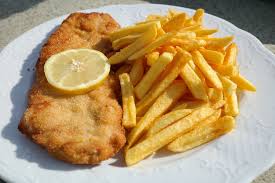
She needs no introduction; the German schnitzel has placed itself on menus globally, but eating it on the streets of Berlin is a whole other story.
While there are various versions of schnitzel around, the German way of making it is with pork. It has to be breaded and then pan-fried until the breadcrumbs become crunchy. When you order a portion of it, it will usually come alongside some french fries.
The controversy around where schnitzel comes from still remains to this day, as both Germans and Austrians claim it as their own. One thing they can both agree on is the cooking method of slapping the slices of meat, which dates back to the 1st century BC.
Where To Eat It?
Tucked down a little alleyway called Reichenberger Street, the Schnitzery Kreuzberg has my heart and always will when it comes to schnitzel. It’s a takeaway food spot with a focus on every Berliner’s favorite dish: schnitzel.
Don’t expect to find a bunch of seats here or anything; the way things roll here is you order, grab your bites, and go indulge. On the off chance, there might be one of the benches out front, but they’re usually snapped up in seconds.
My schnitzel came with the classic portion of crunchy fries, and as soon as I inhaled that aromatic smell of pork, I was ready to dig in. It was so succulent and delicate with a light, sweet aftertaste, and the chips were lightly salted and quite starchy with minimum grease.
The Schnitzery Kreuzberg (€€) – Reichenberger Str. 176 Laden Nr. 14, 10999 Berlin, Germany – Sunday to Thursday, 11:00 am to 10:30 pm, and Friday and Saturday, 11:00 am to 12:30 pm
Eisbein
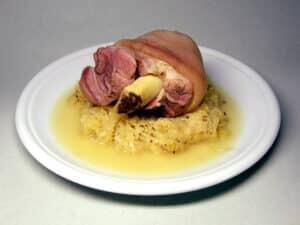
Messy and oh-so scrumptious, eisbein is another must-try street food that I urge everyone to try when they get to Berlin.
Eisbein is cured and boiled ham hock (pork knuckle) loved for its crispy crust, juicy texture, and mouthwatering skin. If you were to order it at one of Berlin’s street food markets, you’d be served it with a side of potatoes and/or sauerkraut.
Where To Eat It?
To try the finest eisbein, you must be willing to travel outside of the city center to Gasthaus Krombach, a traditional German haunt in the suburbs near Berlin Zoological Garden.
Elegant and classically German in so many ways, Gasthaus Krombach is a local restaurant that I read a lot about online for their eisbein. So many people had raved about the place, so my inner foodie told me to go investigate on my last trip to Berlin.
This was the first time I had ever tried eisbein, and when I saw it dropped on the table, I didn’t realize the pork was to be served that pink.
However, when I sliced a piece off with my fork and scrapped up a bit of sauerkraut to go with it, the sweet porky and nutty elements blended with the sourness from the sauerkraut had me diving into the rest of it uncontrollably.
Gasthaus Krombach (€€) – Meinekestraße 4, 10719 Berlin, Germany – Every day, 12:00 pm to 12:00 am
Conclusion
You’ve officially dipped your feet into the street dining culture of Berlin! These are only some of the delicacies you can expect when you get here. Don’t forget to try some mate tea, shawarma, splitterbrötchen, and the list goes on.
And, not to forget, you’ll also have to bounce around the likes of the Thai Park and the Breakfast Market to really try something special.

